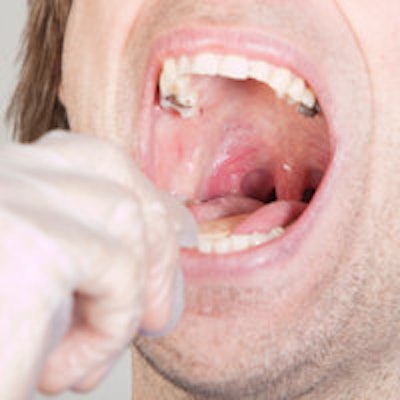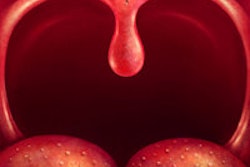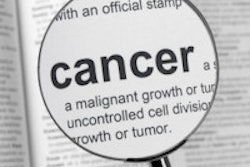
There is insufficient evidence to recommend for or against oral cancer screening in asymptomatic adults age 18 years or older by primary care physicians, according to a study published in the Annals of Internal Medicine (November 25, 2013). The researchers also did not find direct evidence of whether screening reduces morbidity or mortality among the general or high-risk U.S. population.
The U.S. Preventive Services Task Force (USPSTF) noted in its recommendation that its study focused on oral cavity screenings performed by primary care providers, not dental providers or otolaryngologists. It reiterates the group's 2004 recommendation, which also found insufficient evidence to recommend for or against screening.
The report did not include an evaluation of the evidence on oropharyngeal cancer, which cannot be adequately visualized in primary care settings, the researchers noted.
USPSTF researchers reviewed published evidence to determine if oral cancer screening in primary care settings reduces morbidity or mortality. They also assessed the accuracy of screening for identifying oral cancer or its precursors.
Oral and pharyngeal cancers include cancers of the lip, oral cavity, and pharynx (nasopharynx, oropharynx, and laryngopharynx). Some 90% of all cases of oral cancers are classified as squamous cell carcinoma.
There will be an estimated 41,380 new cases and 7,890 deaths from cancer of the oral cavity and pharynx in 2013, according to the U.S. Centers for Disease Control and Prevention (CDC). At the time of diagnosis, more than 50% of people with oral cancer have regional or distant metastases, according to the National Cancer Institute.
"Screening for oral cancer may be helpful if potentially malignant disorders can be identified earlier and treated successfully," the researchers wrote.
Oral and oropharyngeal cancer have different etiologies, they noted. Nearly three-fourths of all oral and pharyngeal cancer cases occur in men, making it the eighth most common cancer in men in the U.S. It's the 14th most common cancer in women.
Risk factors include tobacco and alcohol use, male sex, older age, the use of betel quid, ultraviolet light exposure, infection with Candida or bacterial flora, and a compromised immune system, according to the authors.
Risk factors, HPV
Oral cavity cancer is predominantly caused by tobacco and alcohol use. Up to 75% of oral cancers are attributable to tobacco and alcohol use, but sexually transmitted oral human papillomavirus (HPV) infection (HPV16) has recently been recognized as an increasingly important risk factor for oropharyngeal cancer, the researchers noted.
“Continued research is needed to determine the accuracy of screening in U.S. patients who are at increased risk.”
Since 1979, the incidence of HPV-positive oropharyngeal squamous cell carcinoma has increased. From 1998 to 2004, HPV-negative oral cancer has declined from 2.0 cases per 100,000 persons to 1.0 case per 100,000 persons; HPV-positive oropharyngeal cancer has increased more than threefold, from 0.8 cases per 100,000 persons to 2.6 cases per 100,000 persons, they said.
The overall prevalence of oral HPV is estimated to be 6.9% in U.S. adults ages 14 to 69 years. However, HPV prevalence can be as high as 20% for people who have more than 20 lifetime sexual partners or use tobacco. The prevalence of type-specific HPV16 is estimated at 1% in adults ages 14 to 69 years (an estimated 2.13 million infected individuals). HPV16 is associated with approximately 85% to 95% of HPV-positive oropharyngeal cancer cases, the authors noted.
More than half of all patients with oral and pharyngeal cancer have regional or distant metastases at the time of diagnosis. Relative five-year survival is 82.4% for localized disease, 55.5% for regional lymph node spread, and 33.2% for distant metastases, studies show. Patients with HPV-positive oropharyngeal cancer are diagnosed an average five years younger and have improved survival compared with patients with HPV-negative oral cancer, according to the researchers.
"The epidemiology of HPV-related oropharyngeal cancer is evolving and could have important implications for the identification of high-risk populations that might benefit from screening," they wrote.
It is not known whether current HPV vaccines such as Gardasil and Cervarix can prevent infection at noncervical sites and help reduce the risk of oropharyngeal cancer, they noted.
Harms of detection and early treatment
The study found inadequate evidence on the harms of oral cancer screening. But the authors did note that potential diagnostic harms primarily relate to the harms of biopsies. Harms of treatment for screen-detected oral cancer and its potentially malignant precursors (leukoplakia, erythroplakia) may result from complications of surgery, radiation, and chemotherapy.
Current practice
In a 2008 survey of U.S. adults, 29.4% of adults age 18 years or older reported ever having an oral cancer examination in which a doctor, dentist, or other health professional pulled on their tongue or palpated their neck, the researchers found. Adults who are most at risk for oral cancer (current smokers age 40 or older) are less likely to have ever had an oral cancer examination compared with former smokers or adults who have never smoked.
Screening tests
Additional tests have been proposed as adjuncts to the oral cancer screening exam, such as toluidine blue dye staining, chemiluminescent and autofluorescent lighting devices, and brush cytopathology. But these tests have not been adequately tested in primary care nondental settings, the study authors noted.
Toluidine blue was not found to significantly improve screening for premalignant or malignant lesions, did not affect the incidence of oral cancer, and did not improve outcomes, they said.
The report cited seven studies (total cohort = 49,120) that examined the performance characteristics of the oral screening examination. The studies were generally conducted in settings with an increased incidence of and mortality from oral cancer (India, Taiwan) compared with U.S. rates, the panel reported. The studies also had considerable heterogeneity and showed great variation in test performance characteristics.
Across the seven studies, sensitivity for oral cancer or potentially malignant disorders ranged from 18% to 94.3% and specificity from 54% to 99.9%. The positive predictive value (PPV) ranged from 17% to 86.6%, and the negative predictive value from 73% to 99.3%.
Two U.K. studies looked at oral examinations performed by general dentists among older adults (age 40 years or older) at increased risk because of alcohol and tobacco use and a mixed sample with unknown risk factors. The dental examination in the high-risk sample (n = 2,027) showed a sensitivity of 74%, a specificity of 99%, and a PPV of 67%, while the study of patients with unknown risk factors found a sensitivity of 71%, a specificity of 99%, and a PPV of 86%.
ADA's stance
Recent national news stories about oral and pharyngeal (mouth and throat) cancers reinforce the value of cancer screenings, according to the ADA.
"The American Dental Association has long emphasized that regular oral examinations by a dentist are the best methods to detect mouth cancer in its early stages," the ADA said.
The ADA noted that it is important for patients to be aware of the following signs and symptoms, and to see their dentist if they do not disappear after two weeks:
- Sore or irritations that don't go away
- Red or white patches
- Pain, tenderness, or numbness in the mouth or on lips
- Lumps, thickening, rough spots, crusts, or small eroded areas
- Difficulty chewing, swallowing, speaking, or moving the jaw or tongue
- Changes in the way teeth fit together when the mouth is closed
Conclusion
The researchers found no evidence on screening for oral cancer by primary care physicians in the general or high-risk U.S. population, nor did they find direct evidence on whether screening reduces morbidity or mortality among those populations.
"Continued research is needed to determine the accuracy of screening in U.S. patients who are at increased risk by primary care providers, dental hygienists, dentists, or other trained individuals," the USPSTF concluded.



















